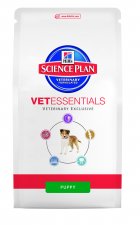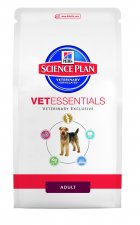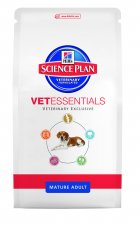Feeding your Dog
© Daisy Street Vets Blackburn
The best, simplest and easiest way to feed your dog is by using a good quality complete dry food.
The following information will help to explain why.
- A good quality dry dog food is easier to feed and store.
- Good quality dried foods contain all the vitamins and nutrients to ensure the best nutrition for your dog.
- A good quality dry food does not smell strong and is more hygienic.
- A good quality dried food is overall cheaper to feed on a daily basis than wet food, even though the cost of a whole bag seems expensive.
- A properly formulated dry food will help to keep your dog's teeth clean.
Make sure it is a good quality dried food that you choose. Cheaper dried foods have their limitations.
Feed a top quality complete dry food.
We recommend Hill's Science Plan Vet Essentials.
We have chosen Hill's Science Plan VetEssentials for our waiting room at Daisy Street because we think is is a very good food, one of the best foods for dogs. The next section will describe the good properties of Vet Essentials and the points raised should help you in choosing your dog's food.
- It is a life stage food. Dog's require different balances of nutrients when they are young, middle aged and old. Hills VetEssentials meets these requirements.
- It is specially formulated to help keep your dog's teeth clean. Look out for the tooth symbol on dried food. Remember hard dry feeding helps to keep the teeth clean.
- It is formulated to help to control body weight.
- It is made from high quality human grade ingredients.
- It promotes urinary tract health. Older and cheaper dried dog foods can sometimes upset the urinary system leading occasionally to bladder problems.
- It is easy to digest, producing smaller, firm and non-smelly poos (relatively anyway, as all poo smells a bit).
- The puppy stage food helps the immune system, the mature dog food supports the internal organs especially the kidneys.
- It helps to promote a good coat and skin (reducing dandruff and shedding) due to high levels of essential oils.
- Much easier to feed and store.
- Much more economical than canned food.
When choosing a dog food make sure it addresses the above points. If you want to use VetEssentials food then we have it in stock for all life stages. Just ask for some to try when you are next in.



A few don'ts:
- Don't buy cheap low quality foods.
- Don't buy huge bags of food that will take your dog months to get through. The food will go stale before it is eaten. Buy small bags that are consumed in a few weeks.
- Don't give too much human food as it may upset your dog. Milk can sometimes cause diarrhoea. Little bits are OK though. If you do give your dog scraps of human leftovers and your dog has soft stools or dandruff for example try cutting out the human food for a month and see if things improve. 10-20% scraps should be fine with most dogs as long as their main food is a good quality one.
- Don't change your dog's food suddenly. Change the food gradually over time.
- Don't restrict the water. Make sure there is always plenty of fresh water to drink when feeding dry food.
When should I feed my dog?
After you have eaten is the best time. 2-3 meals a day for an adult dog. More frequently for puppies and some older dogs. Leave the food down for 10-15 minutes only. Then you must take it away until the next meal. Do not leave food down for your dog (cat's must have food down all the time). You must be in complete control of your dog's feeding to help with behavioural control.
How Much Should I Feed?
There are usually guidelines on packets of dog food. These are guidelines only and almost always on the high side. Go off the recommended amount, but if you think your dog is getting portly, cut it down. Most dogs are hungry all the time. They have huge stomachs in comparison to their body size and can eat huge amounts if given the chance (ask any labrador owner!). So usually a dog will ask for more! Do not give into temptation or you will end up with a fat dog (with health problems). If your dog's appetite is a problem you could always try something like Hill's R/D which is full of fibre and low in calories, designed to fill the hungry dog up (for more details contact the surgery).
Should I Give My Dog A Bone?
This is a difficult one. Dog's do not need to eat bones. Dog's enjoy gnawing bones, bone's contain lots of calcium, help to keep your dogs teeth clean and keep their jaws strong. On the down side bones can break teeth and, much worse, chunks of swallowed bone can get stuck inside the throat or intestines requiring surgery. Most dogs are fine with bones.
Avoid small bones. Avoid cooked bones. You must throw chewed bones away after 24 hours as they are a hygiene risk. If you do get a bone get a fresh big one from a butcher to minimise any problems. It is best to start with bones as a puppy, A mature dog who has never had a bone before may bite off big pieces and swallow them whole or break their teeth.
Daisy Street Vets in Blackburn February 2015
.jpg) 30 years ago..... (David Higginson MRCVS remembers)
30 years ago..... (David Higginson MRCVS remembers)
We rarely talked about a dog's diet. Dogs were generally fed on scraps or canned food of dubious quality. Many dogs were overweight, smelly, had irregular motions, poor coat, and awful teeth, and we accepted this as normal! We hadn't yet realised that most of these problems arose for poor quality diet. It wasn't until the late 80's and the introduction of Science Plan and Eukanuba that British vets realised just how much we could improve a dog's health by quality feeding.

.jpg)
